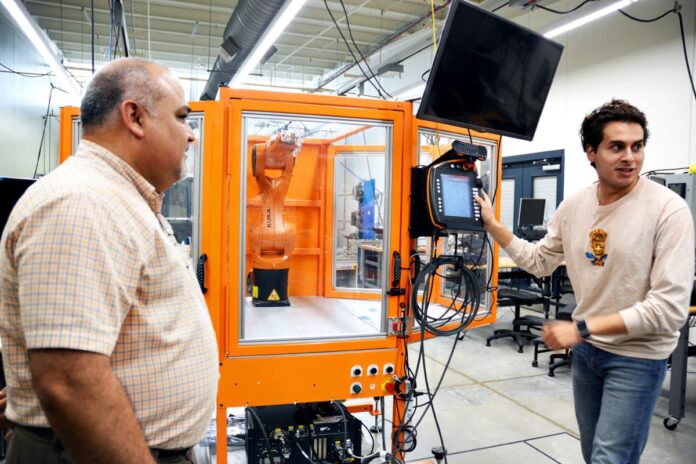HARLINGEN — The yawning cavern that makes up the north wing of the Engineering Center at Texas State Technical College testifies to its origins as a U.S. Air Force hangar.
With half of the facility remodeled three years ago, TSTC officials are ready to make the Engineering Center whole.
This summer the college will embark on Phase II of the remodeling effort, which tentatively will cost $3.5 million and produce two stories with around 25,000 square feet of usable classroom and lab space for STEM studies (Science, Technology, Engineering and Math).
The renovation is scheduled to begin this summer and be finished by August 2018.
“This building has always kind of been in the limelight,” said Adan Alvarez Jr., project manager for TSTC’s Engineering Department, as he walked through the Engineering Center last week.
“We want to keep growing it to show students what they used to call and still do the flexible lab concept.
“That means that these labs can all be interchanged,” Alvarez said. “It takes time, but they can be interchanged because they’re pretty much built alike. They’re flexible where you don’t have things built into the floors, everything is overhead.”
Flexibility is a watchword for TSTC given how fast the technology sector is evolving. Given those rapid changes, students at TSTC are taught they’ll be expected to continue to learn on their own if they want to keep up in their fields.
At TSTC, they teach beyond graduation.
“Self-education here is a big deal,” said Dan Bodnar, master instructor and chairman of the Telecommunications Convergence Technology Department. “Our students learn how to learn.”
The Engineering Center currently houses Mechatronics Technology, where students are taught robotics, Biomedical Equipment Technology, Wind Energy Technology and Telecommunications Convergence Technology.
“The second floor will be the Chemical Technology Department, which is currently housed in Building J,” Alvarez said, gesturing toward the ceiling of the still-empty Engineering Center north wing.
“They’re going to come this year and those will be chemical labs up there,” he added. “There are three labs that are going to get built.
“The lower floor here … we’ll build out the rooms between here and that section and that department will be what they call Architectural Design and Engineering Graphics,” Alvarez said.
It would be easier if merely classrooms were required, but when it comes to STEM, students and instructors need room to explore.
“They’re large labs,” Alvarez said, and many of the departments require space for large equipment as well.
“Down here they’re computer labs for the most part … they will also have a workshop which involves bringing in what they call a Rover, a student project they work on,” he added with a swing of his arm along the first floor.
“It’s actually a little mini-car that they run around with, kind of like a Polaris. It looks more like a Transformer but it’s a Polaris.”
Alvarez said since the designs of all the classrooms and labs are interchangeable, once the new wing is complete it will allow them to move existing departments there and then upgrade the three-year-old classroom/lab spaces.
“It adds a lot of value,” he said. “It adds a lot of recognition to the school knowing that we’re moving forward and we’re improving our facilities.”
And it isn’t just TSTC officials who are convinced the college’s focus on technology education is of particular value to the Rio Grande Valley.
“TSTC is a great asset to the state, the region and especially to Harlingen,” said Raudel Garza, chief executive officer for the Harlingen Economic Development Corp.
“It is absolutely vital to our continued economic growth for schools to add to their offerings of advanced degrees and certifications in order to prepare our workforce and to attract quality employers.”
Lynda Lopez, executive director of the school’s communications office, said she feels the latest renovation of the Engineering Center shows students and prospective students that TSTC means business, too.
“It adds support to our commitment to STEM learning, STEM education,” she said. “Because that’s what we’re really about, pushing these engineering technologies.
“This really takes us to the next level with our STEM learning.”
– 1940s — Hangar used by U.S. Air Force
– 1980s — Metals and door manufacturing plant
– 1990s — Aviation and space programs, Lockheed Martin
– 2010 — TSTC takes over building shell
– 2014 — Renovation of about half the space for STEM classes completed (Science, Technology, Engineering and Math)
– 2017-18 — Phase II to bring additional 25,000 square feet for classes, labs





